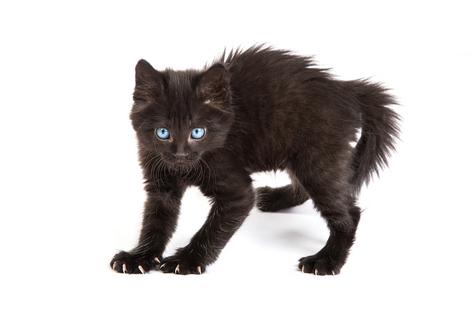My Pet World: How to train a scared but friendly cat to let you pet it
Dear Cathy,
I am the mother of an adorable, almost grown, black kitten. While she is friendly, she won't let me pet her. Whenever I reach towards her, she dodges my hand. Someone might have hit her before I adopted her from an animal shelter. It doesn't help that my brown tabby chases her and is cross with her. How can I convince my little black cat that I only want to pet and love her?
— Marian, Lincoln, Nebraska
Dear Marian,
You can train her to accept your touch. Get a stick or wand long enough to reach her, but that keeps you at a distance so that she won't bolt. Tap the stick lightly on the floor or furniture around her. If she stays put, use a training clicker to mark the correct behavior and toss her a treat.
When you think she is ready, make sure she is looking at you before touching her with the stick. If she runs, return to touching the floor around her again. If she stays put when you touch her, click the clicker, and toss her a treat. Each day, scoot a little closer to her and keep clicking and rewarding every baby step until you can touch her without her running. This training could take days, weeks, or months. But if you are diligent, you can train your scared, but friendly feline to feel safe in her world.
Dear Cathy,
We rescued a basenji mix as a puppy who is now almost five years old. He is high energy and very smart but was hard to train. He has two weird habits.
First, he likes to carry his dry kibble from his bowl in the kitchen into another room to eat it. Second, after getting a bath and towel dried, he gets the zoomies, running around the house, rubbing against the sofa, and jumping on the recliner. It takes him about five minutes to calm down. Any thoughts on these behaviors?
— Mary Rose, Valley Stream, New York
Dear Mary Rose,
These two weird habits are fairly normal behaviors for dogs. Dogs may take kibble from their bowl and eat it elsewhere because they want to eat with others, and you are in the other room. They may want to protect or hide their food, a behavior more often seen when there is more than one pet in the house. Or, a dog may not like his food bowl because it's too deep or too small to eat from, or their tags clang on the bowl.
Dogs may get the "zoomies" after a bath for many reasons. A dog may be happy the bath is over and is anxious to escape the bathing area. The dog may get excited at bath time, which causes an adrenaline rush, which leads to the zoomies. Or the dog may not like being wet or may have water in his ears, so he runs to shake his head and dry off.
While you can sit with your dog when he eats or change his bowl to see if that changes his eating behavior, the zoomies after a bath are simply part of your dog's unique personality traits.
Dear Cathy,
I have a nine-year-old male indoor cat named Cream Puff. He was feral for about five years when someone rescued him and took him to our shelter for medical treatment. He has Feline Immunodeficiency Virus (FIV) but remains healthy.
He's a very loving cat, but he likes to bite and claw my hand while lying on his back and sitting on my lap. I know he's playing and not being vicious. I've tried to correct this biting and clawing behavior but to no avail. What do you recommend?
— Mark, Lynchburg, VA
Dear Mark,
Petting-induced or overstimulation aggression occurs when a cat, who may enjoy touch, has suddenly had enough. You can't correct this, but you can honor and redirect the behavior. Honoring it means watching your cat's body language, so you know when to stop.
He may stiffen his body or flick his tail, which indicates he’s about to react. Or, he may only tolerate four or five strokes before reacting. Always stop petting him before he reaches his threshold, and give him some time to calm down. When your cat is on his back, do not pet or use your arms or hands to touch or play with him. Instead, give him a stuffed sock to play with instead, so he can bite and claw the toy and not your hand.
(Cathy M. Rosenthal is a longtime animal advocate, author, columnist and pet expert who has more than 25 years in the animal welfare field. Send your pet questions, stories and tips to cathy@petpundit.com. Please include your name, city, and state. You can follow her @cathymrosenthal.)
©2023 Tribune Content Agency, LLC.
(c) 2023 DISTRIBUTED BY TRIBUNE MEDIA SERVICES, INC.










